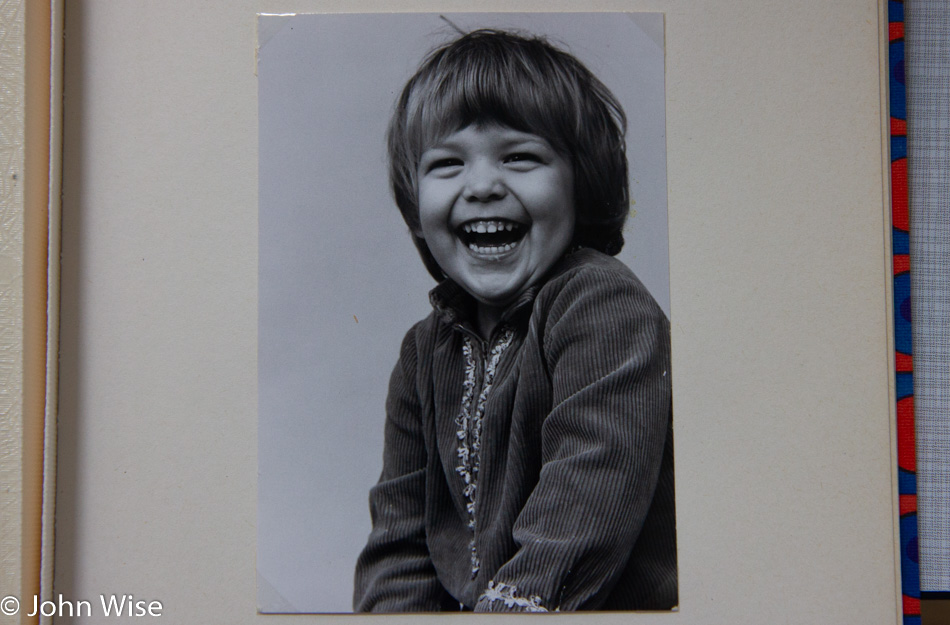
It was around 1970 when this photo was taken of Caroline sitting on a stuffed bear she “really” wanted, but at about 1,000 Deutsche Marks at the time, she wasn’t going to be riding the bear at home any time soon. We were at my mother-in-law’s early this morning, and while she had a bite to eat, Caroline and I went through a couple of old photo albums. We’ll be dragging them back to the States with us, where I’ll scan them to have better copies than what I made here using my camera.
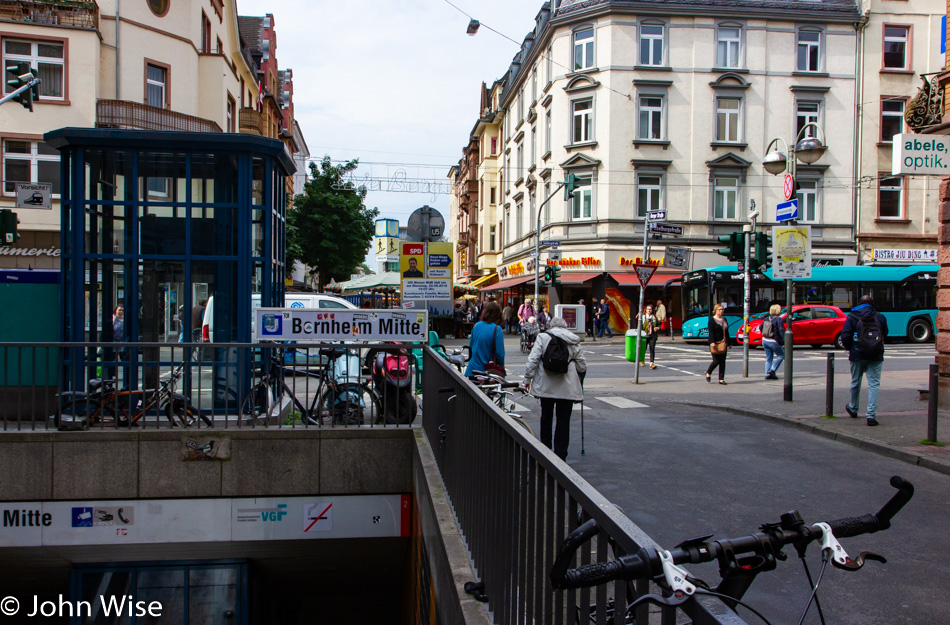
Once breakfast and meds were dealt with, we needed to make our way to the nearby subway stop for a quick ride to the Hauptbahnhof, where we transferred to the S8 for a 30-minute ride to Mainz on the Rhein River.
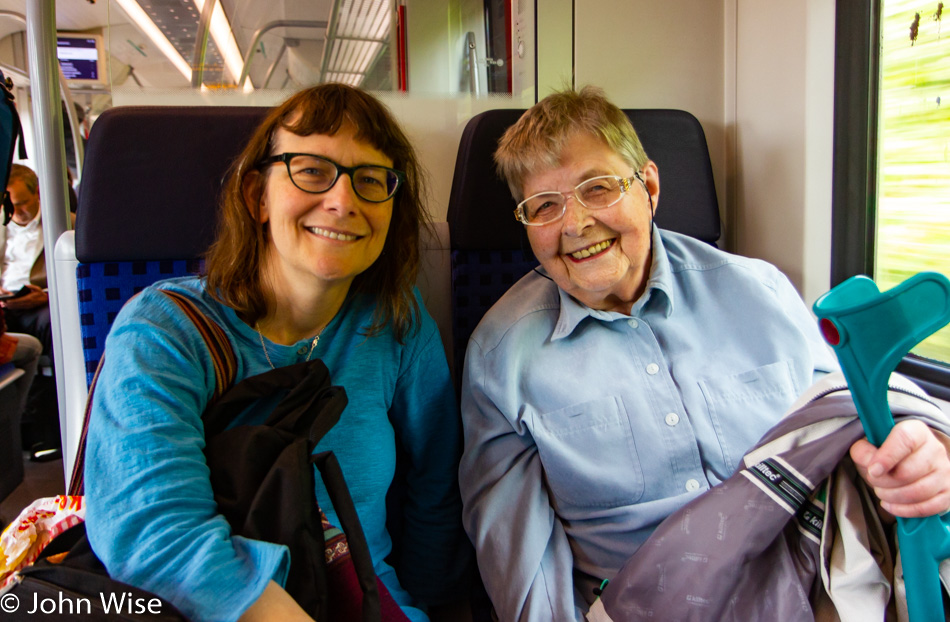
The reminder about the efficiency, smoothness, and convenience of a proper public transportation system resonates hard with me as I’m able to plug in my headphones, open my computer, and work on my blog while underway. The only problem with that was I couldn’t watch where we were going so within a couple of minutes, I put the computer away and put my attention on watching my surroundings. The two women in front of me were busy cackling away in German, so my headphones use didn’t have me feeling like I was isolating them, but instead, I was adding the soundtrack that someday listening to these songs again will help bring me back to this moment.
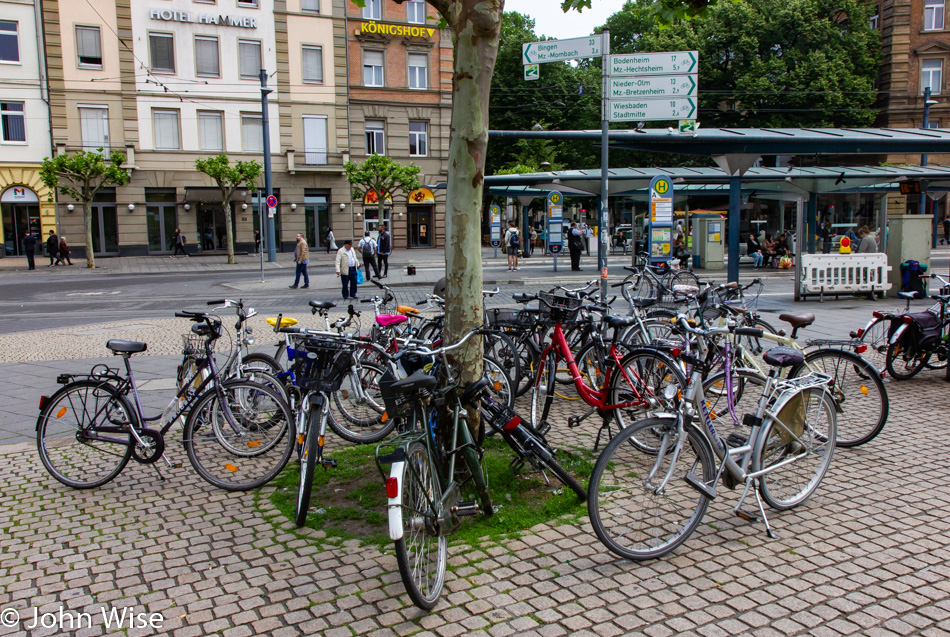
Utilizing public and alternative transportation compared to our car culture in America feels enlightened these days. When I came to Europe so many years ago, it felt primitive and old-fashioned, but with obesity, pollution, and the isolation that comes with our cars, I can’t help but see the benefits of doing things differently. While not obvious in this photo, I’ve seen a lot of electric-assist bicycles that I can’t help but think would be stolen across America when locked up, like these freestanding bikes that could easily be thrown in the back of someone’s pickup truck. Another small note: it’s nice not to see anyone wearing guns.
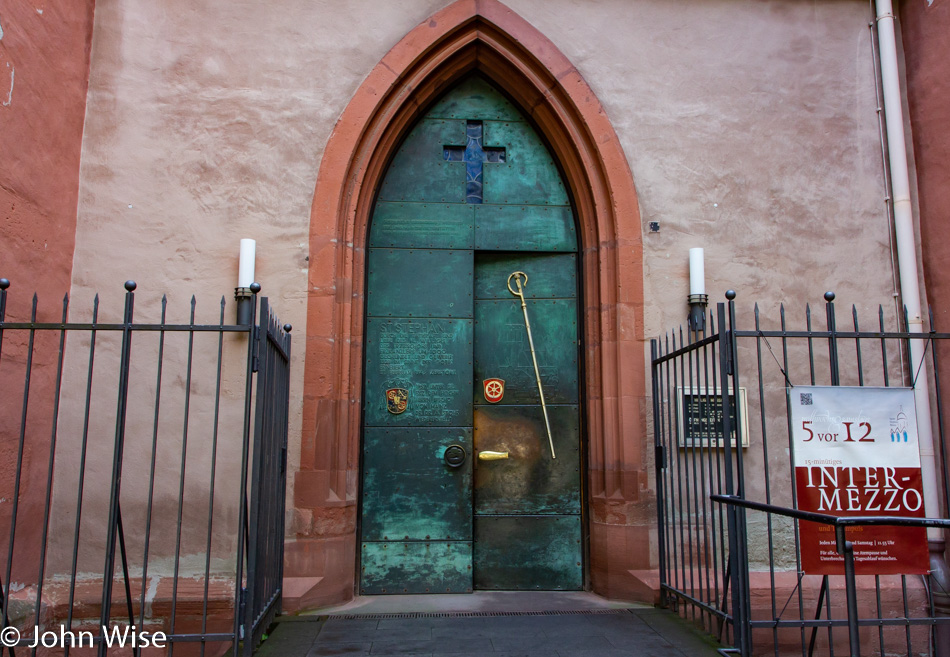
This church was at the center of the reason for coming out to Mainz. It is St. Stephan and is the home of glasswork by Marc Chagall. The church was originally founded in the year 990 but has been destroyed and rebuilt more than a couple of times. After World War II, the church had to be restored due to bombing near the end of the war, and by 1978, it was time to replace the glass.
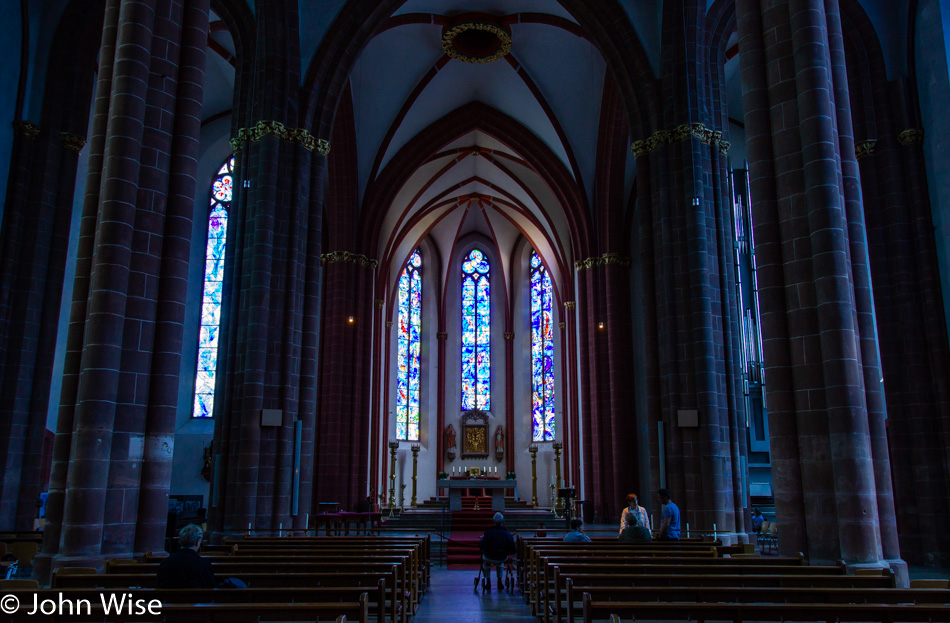
The blue light inside the church adds a beautiful hue to the environment. Before Marc Chagall died in 1985, he had completed nine windows with the black paint done by hand. Following his death, an associate of Chagall’s for 28 years finished the glasswork.
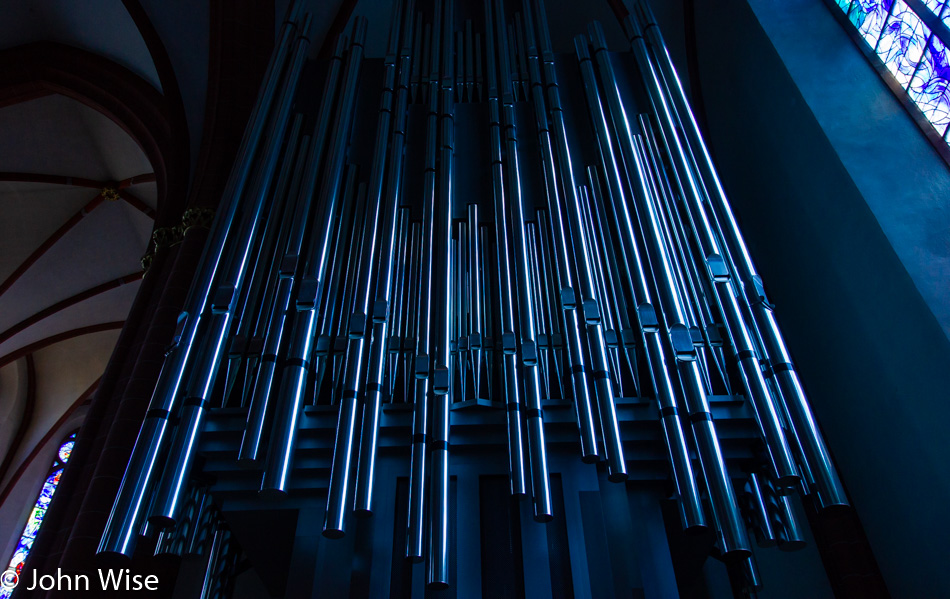
We missed an organ performance by 10 minutes, which is only performed twice weekly at 11:55 a.m. for a mere 20 minutes.
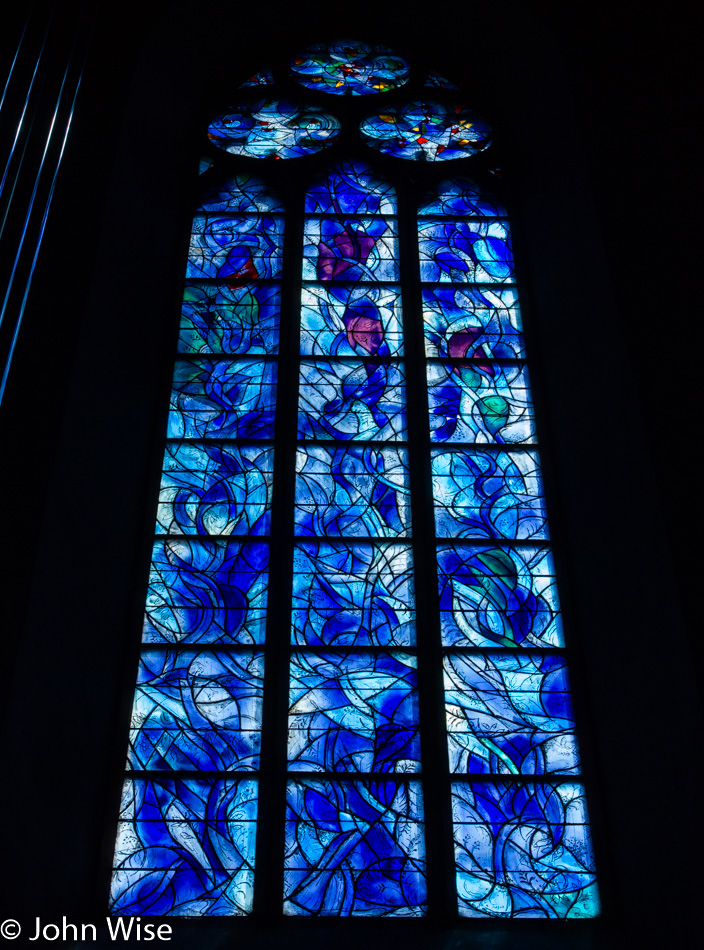
Detail from one of the windows finished by Chagall’s associate Charles Marq.
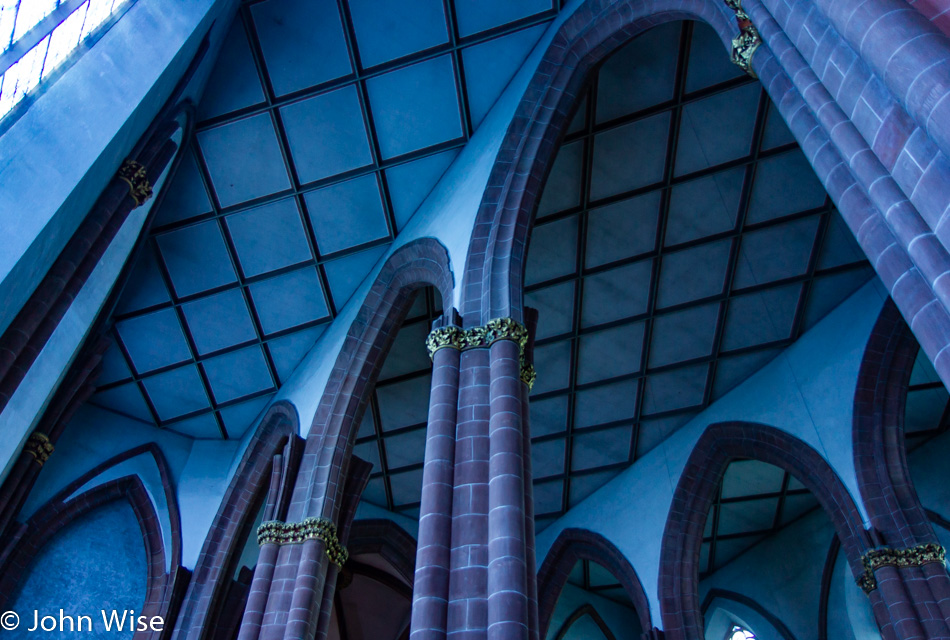
Caroline and I will never pass up a visit to an old church or cathedral, as they are often architectural wonders with an atmosphere of light, smell, temperature, lines and angles, sounds, and history that leave great impressions.
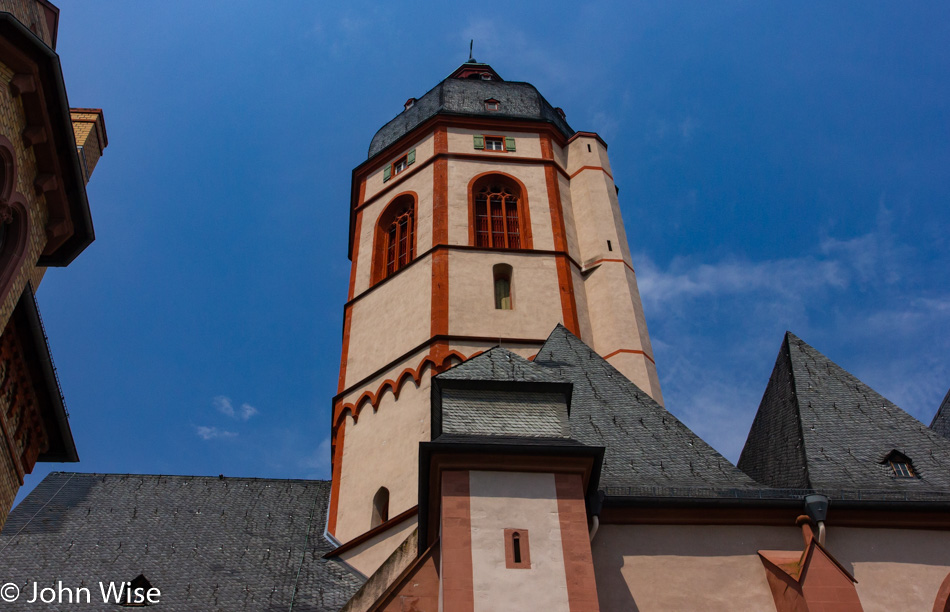
The exterior of St. Stephan Church in Mainz, Germany. Little did we know with these blue skies that a thunderstorm was soon going to arrive.

Jutta will be turning 83 years old this July. Sadly, her short-term memory is disappearing at an ever-increasing pace. An hour or two after eating, she doesn’t know what she had or where she was. As is often the case, she has very clear memories of her past and still knows many of the details of all of her trips to the States. When on Friday we head south to France, I’m not very confident that she’ll remember that we were visiting her this week.

A quick check on Google showed a place with a Michelin acknowledgment called Heinrichs Die Wirtschaft. Around the corner and up the hill, we dragged Jutta along and were happy we did. This is Caroline’s dish of calve in green sauce with roasted potato. Not pictured is my chicken breast with white asparagus and potato.

Jutta opted for the rosefish and shrimp with white asparagus and potato. We did a three-way split on a dessert of raspberry compote with whipped hazelnut cream and vanilla ice cream. Throughout this vacation, I will likely feature too many photos of food, but when outside of our routine, much of the food we enjoy can have as powerful an influence on our memories as the antiquities we search out.
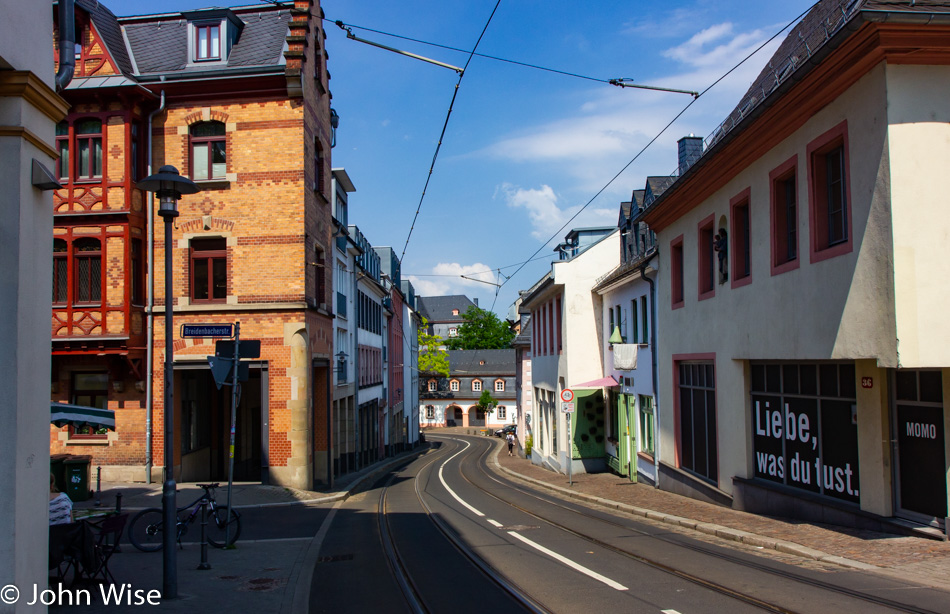
In the window on the right, the sign reads, “Love what you do.” We do.

We take more breaks than would be normal with Jutta as her stamina has been declining along with her memory. Fortunately, we were able to bring her to New York City, Washington D.C., and San Francisco back when, with a bit of a push, we could prod her into walking upwards of 12-15 km per day, even in her 70s! This is the Carnival Fountain at Schillerplatz, which was created back in 1967; it is also one of our rest stops.
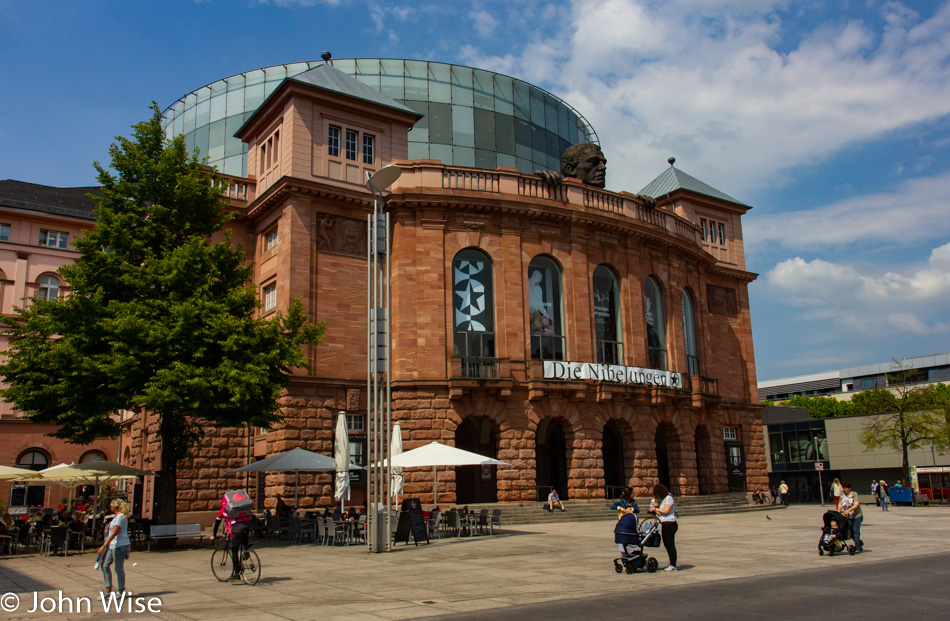
The Mainz Staatstheater looks to have some very interesting performances being put on that would probably be too obscure to play in Phoenix. This is especially tragic as Mainz only has a population of a shade over 200,000 while the greater Phoenix area has more than 2.5 million inhabitants. I guess an education in history and culture has its rewards.

Market Square in front of Dom St. Martin is our next place to visit.
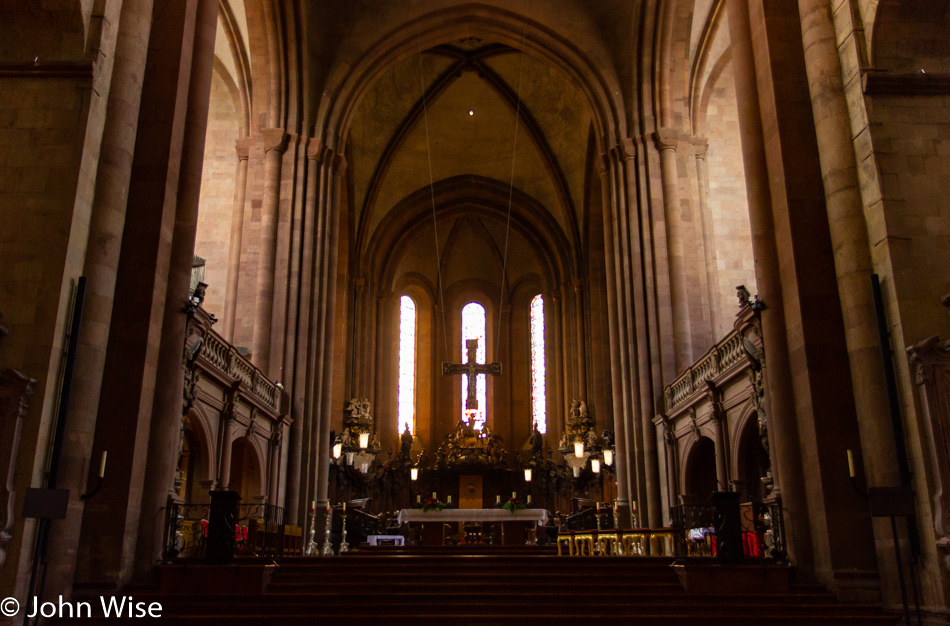
Dom St. Martin in Mainz, Germany. In German “Dom” is a cathedral. The origins of this church date back approximately 1,000 years, and if you’d like to know more about it, there is an incredibly detailed story about its history, strange acoustics, and consideration for the organ over on Wikipedia.
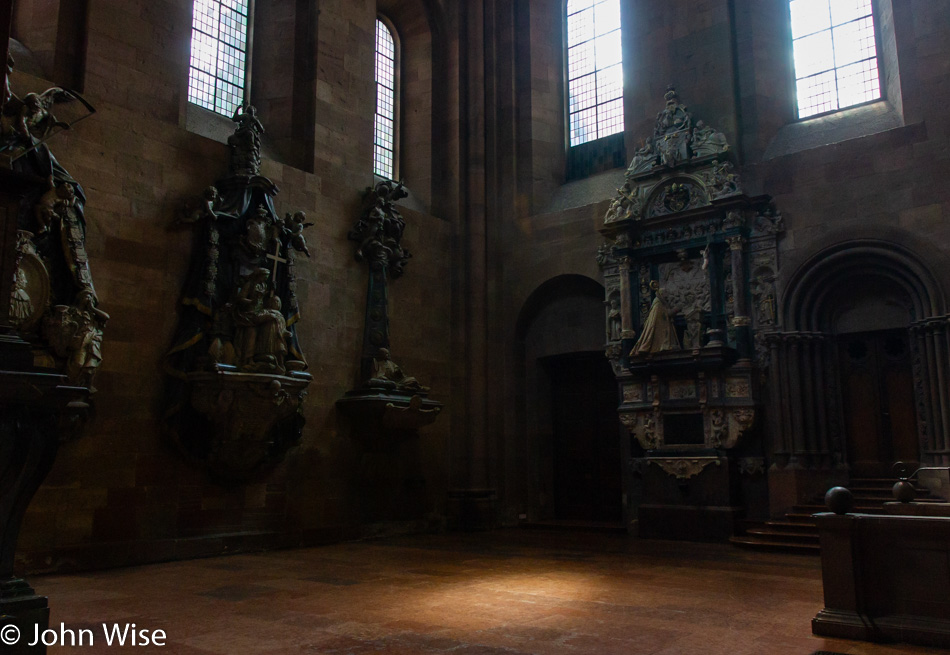
Like many cathedrals, visits should occur at different times of the year so one can experience the light within. Weather and time of day also play large roles in the aesthetics.

Fine details abound, and no relatively short blog post will ever capture all that can be seen.
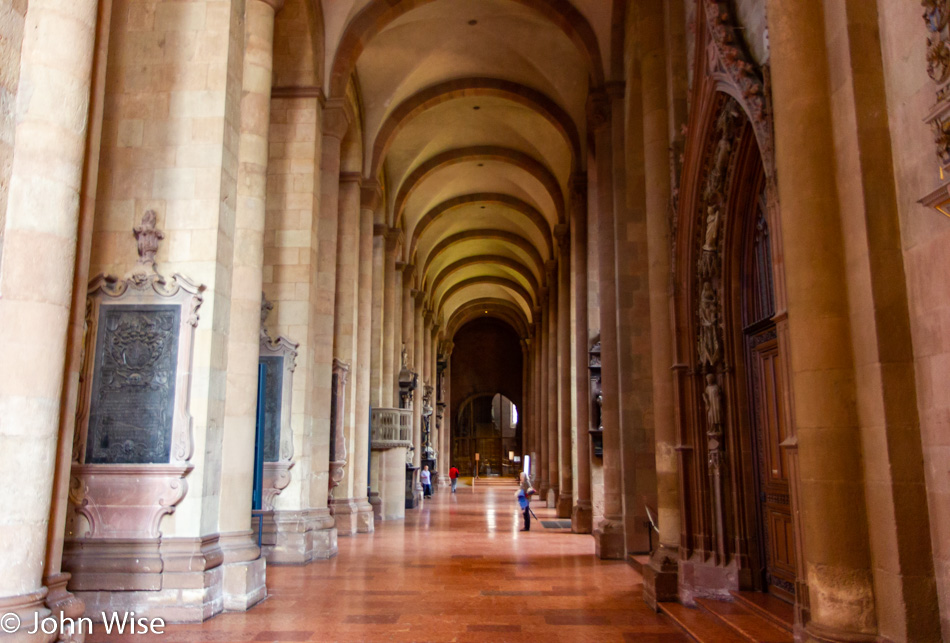
Grandeur also has its role.

I don’t believe when we are young; we can quite understand the connection and continuity of histories that stretch back a thousand years and how churches are living bridges between the ages. While I have been to the Washington National Cathedral and St. Patrick’s Cathedral in New York City, there’s another feeling when entering a cathedral built when the Vikings were active, Islam was in its golden age, and the Holy Roman Empire was taking control of Europe while America would remain unknown to Europeans for more than 500 years.

Caroline will have to add more information about this image as she was the one who requested I snap this for her.

Plaque in the dedication of the Dalberg family dated 1606, who were nobles. By 1848, the family became extinct.
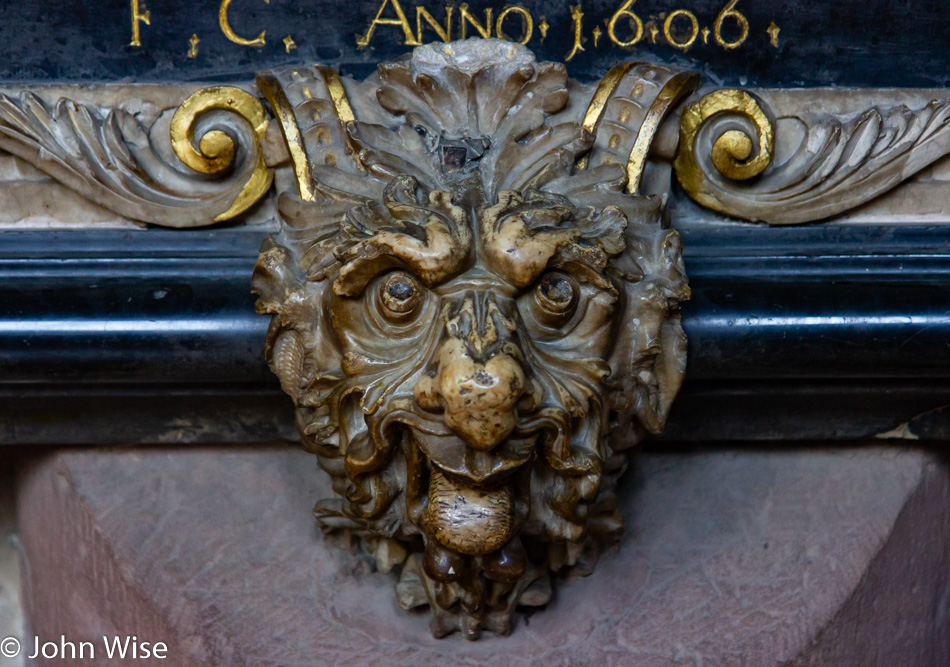
Detail of the plaque from above.
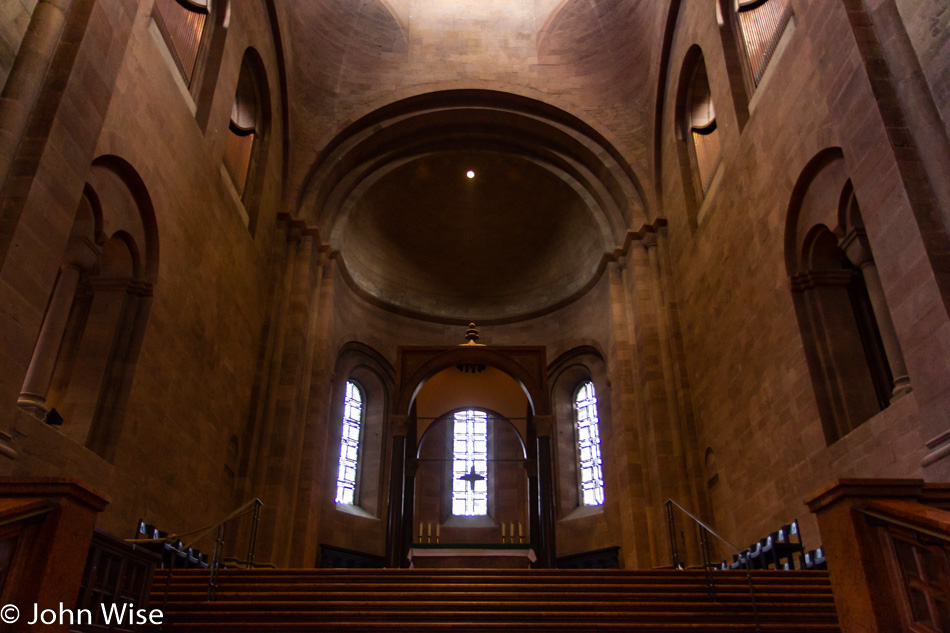
The back of the cathedral is just as elegant to me as the front.

We’re on vacation, so it’s total indulgence all the time. Stepping out of the cathedral, there were many sidewalk cafes on the square; we took the first free table we found and ordered coffee and a banana split. We probably didn’t get a bite into our sweet treat, and the rain started; no problem because others took shelter in the cafe, so we took their place under the awning.
From the cafe, we grabbed a taxi back to Mainz Hauptbahnhof and our trip back to Frankfurt. After walking Jutta back to her apartment, it was approaching the time for dinner, believe it or not.
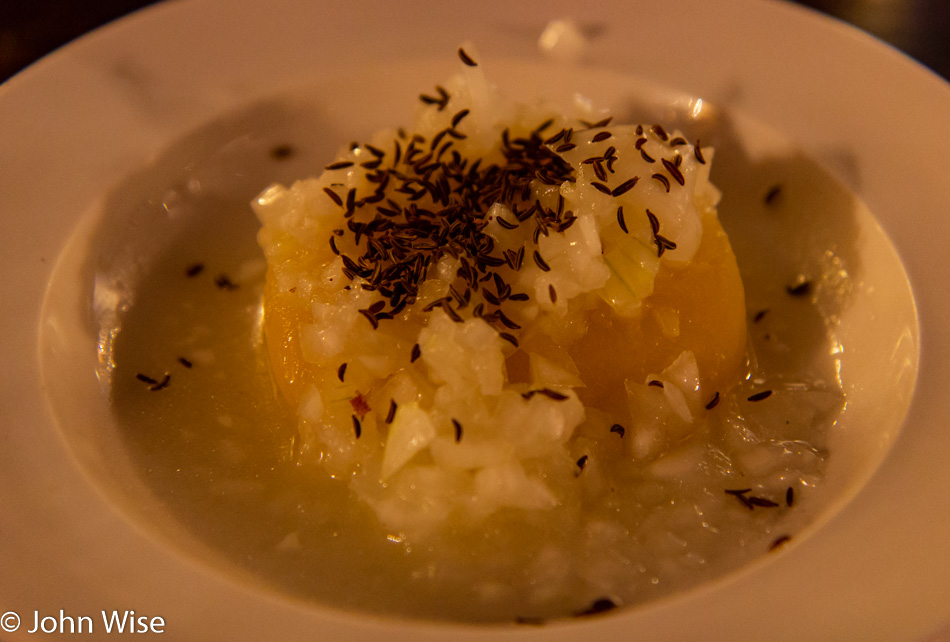
The number one rated restaurant for traditional German food as rated on Yelp is Ebbelwoi Unser over in Sachsenhausen. The place is nearly packed, and the menu is relatively simple, but our first impressions let us understand why this place is so highly rated. We started by sharing another Handkaese mit Musik (hand cheese with onion and cumin), and this was the best yet of the three or four we’ve tried so far.

This was Caroline’s meal of Leberknodel mit Specksosse, Apfelsauerkraut und frischem Kartoffelpuree (liver dumplings with gravy, sauerkraut with apple, and mashed potatoes. This was an incredible bargain, costing less than 10 euros. Of course, Caroline had apple wine with her dinner.

Because I can’t get enough green sauce I ordered the Gekochter Tafelspitz vom Jungbullen mit Gruener Sosse und Pellkartoffeln, loosely translated as calf roast with green sauce and horseradish with boiled potatoes. When I was younger, I would have never opted for sparkling water, but that’s all I’m ordering these days, and I’m thoroughly enjoying the variations.
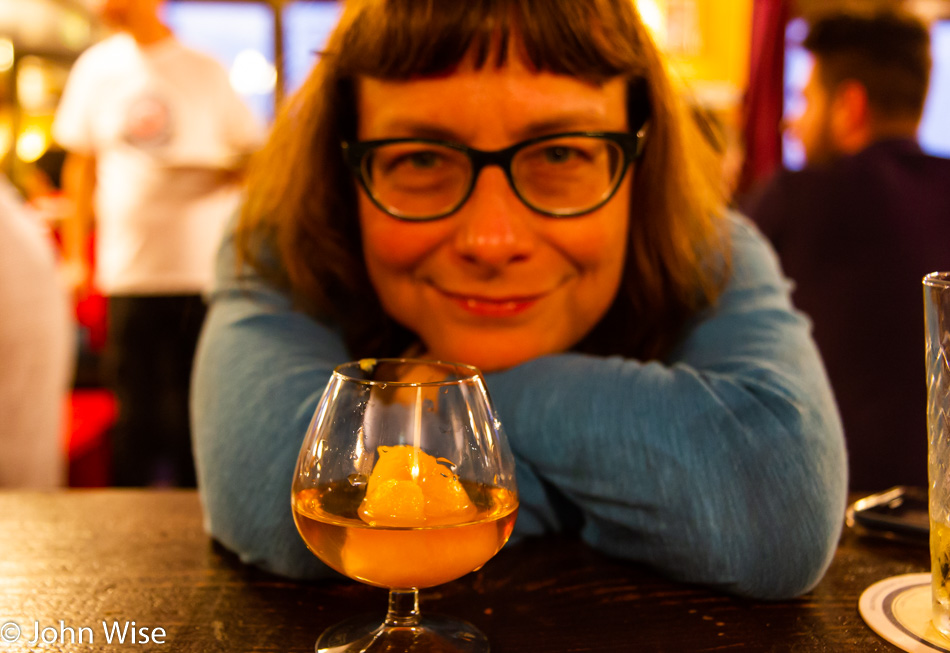
This is a Mispelchen, a local specialty “Medlar” drink. Caroline will fill you in on the details during the editing process of my blog entries. Caroline here: Mispelchen is made from Calvados (apple brandy) and a canned Mispel (in English: medlar) fruit. As it turns out, though, “real” medlars are rare, and it is not uncommon to find loquats in their place. Medlars (Mespilus germanica) and loquats (Eriobotrya japonica) are both members of the Rosaceae family. I found this out because I was trying to find canned medlars here in the US.
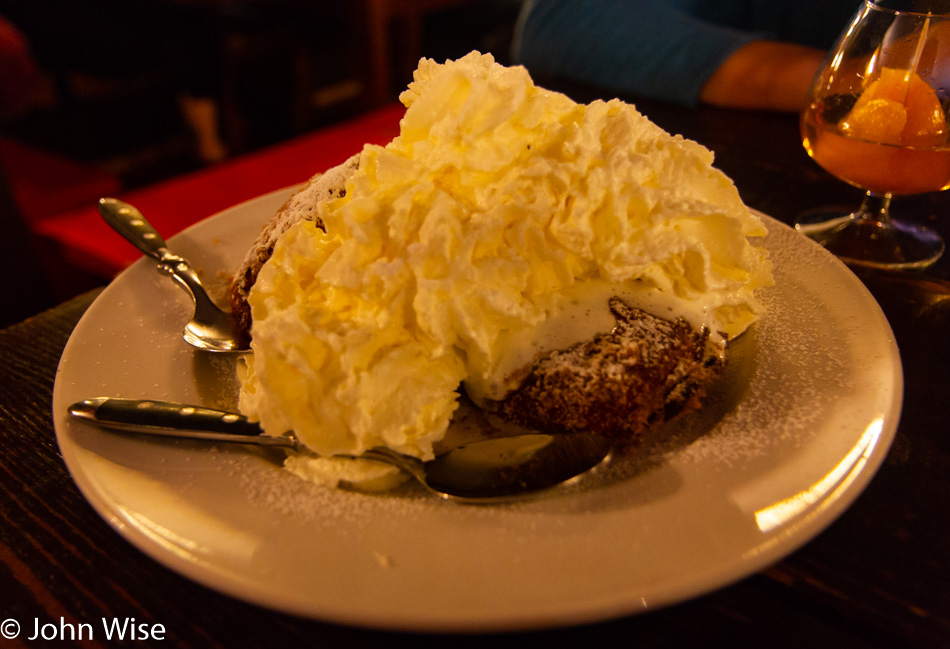
Three desserts in one day must be a record. This one is baked apples in a crust with fresh whipped cream, and ice cream was a perfect end to a great day. I think we used our 14 hours out and about to the best of our ability. Over that time we walked 6.5 miles or 10.5 km and climbed 17 floors, not bad when it’s considered that we had Jutta with us the majority of the day.